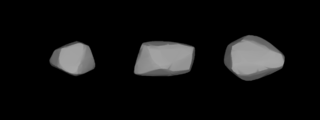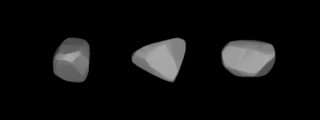Related Research Articles
Messalina is a minor planet, specifically an asteroid orbiting primarily in the asteroid belt. It was discovered on 3 October 1904 by Paul Götz, at Heidelberg. It is named after Valeria Messalina, the third wife of Roman Emperor Claudius.
Olympia is a minor planet orbiting the Sun.
Bilkis is a minor planet, specifically an asteroid orbiting in the asteroid belt. It was discovered by German astronomer August Kopff in 1906 February and was given the Koran name for the Queen of Sheba. Photometric observations at the Palmer Divide Observatory in Colorado Springs, Colorado in 2006–7 were used to build a light curve for this object. The asteroid displayed a rotation period of 8.5742 ± 0.0005 hours and a brightness variation of 0.40 ± 0.02 in magnitude.
Thekla is a minor planet orbiting the Sun. It was named after Saint Thecla of the first century. The name may have been inspired by the asteroid's provisional designation 1906 TC.

Tomyris is a minor planet orbiting the Sun. Its name derives from the Massagetean ruler Tomyris, and may have been inspired by the asteroid's provisional designation 1906 TO.
Irmgard is a minor planet orbiting the Sun.
Mireille is a minor planet orbiting the Sun.

Polyxena is a minor planet orbiting the Sun. This main belt asteroid was discovered on 27 March 1906 by German astronomer August Kopff at the Heidelberg observatory. It was named after the youngest daughter of Priam and Hecuba, king and queen of Troy during the Trojan War. 595 Polyxena is orbiting at a distance of 3.21 AU from the Sun, with an orbital eccentricity (ovalness) of 0.06 and a period of 5.75 yr (2,099.1 d). The orbital plane is inclined at an angle of 17.8° to the ecliptic.
Bandusia is a minor planet orbiting the Sun.
Octavia is a minor planet orbiting the Sun. At 15:45 UTC on October 6, 2014, the 13.5 magnitude asteroid occulted with magnitude 8.1 TYC 1299-00020-1, and was visible in Taiwan.

Musa is a minor planet orbiting the Sun.
Luisa is a minor planet orbiting the Sun.

Nerthus is a minor planet orbiting the Sun. See mythology of Nerthus.
Marianna is a minor planet orbiting the Sun.
Tekmessa is a minor planet orbiting the Sun that was discovered by American astronomer Joel Hastings Metcalf on February 16, 1906. The name may have been inspired by the asteroid's provisional designation 1906 TK.

Juvisia is a minor planet, specifically an asteroid orbiting in the asteroid belt that was discovered 27 August 1906 in Heidelberg by German astronomer Max Wolf. It was named after the commune Juvisy-sur-Orge, France, where French astronomer Camille Flammarion had his observatory.
610 Valeska is a minor planet, specifically an asteroid, orbiting primarily in the asteroid belt. Discovered in 1906 by Max Wolf. The origin of the name is unknown, but it may be related to the provisional designation 1906 VK. In Slavic origin, it also means Glorious ruler. Photometric observations provide a rotation period of 4.9047±0.0002 h with a brightness variation of 0.17±0.03 in magnitude.
611 Valeria is a minor planet orbiting the Sun that was discovered by American astronomer Joel Hastings Metcalf on September 24, 1906, from Taunton, Massachusetts. The name may have been inspired by the asteroid's provisional designation 1906 VL.
612 Veronika is a minor planet orbiting the Sun. It was discovered on 8 October 1906 by August Kopff from Heidelberg. The reason for the name is unknown; asteroid etymologist Lutz D. Schmadel suspects that it may have been inspired by the letter code "VN" in its provisional designation, 1906 VN.
620 Drakonia is a minor planet, specifically an asteroid orbiting in the asteroid belt. It was discovered October 26, 1906, in Taunton, Massachusetts, by American astronomer Joel Hastings Metcalf and given the preliminary designation 1906 WE. It may have been named for Drake University.
References
- ↑ Noah Webster (1884) A Practical Dictionary of the English Language
- ↑ "593 Titania (1906 TT)". JPL Small-Body Database . NASA/Jet Propulsion Laboratory . Retrieved 5 May 2016.